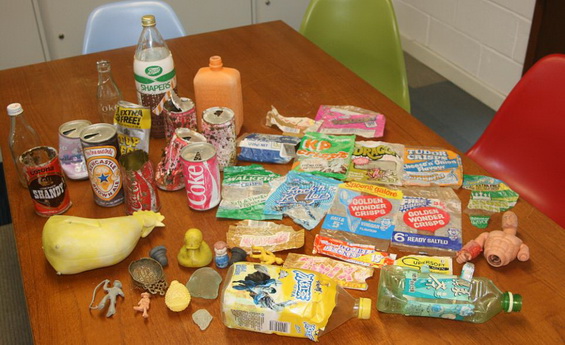Reported by Jennifer Newton in The Daily Mail on May 2, 2014.
Piles of garbage carelessly thrown away on beaches 50 years ago has washed up on Britains beaches in such good condition that the brands could be easily identified.
Among the garbage were crisp packets, beer cans and sweet packets dating back to the 1960, with their colourful packaging barely faded. Their 1967 and 1968 sell-by dates were still visible.

Conservationists Surfers Against Sewage, organised beach clean-up events across the UK last month, collecting 25 tonnes of rubbish.
They say that the fact some of the old rubbish is in near-pristine condition after all these years illustrates how litter can float around for decades without degrading.
Finding this garbage comes on the heels of a Plymouth University study that revealed human litter has been found clogging up some of world’s most remote sea beds.
As Jessica Aldred at The Guardian reported on April 30, 2014, scientists used video and trawl surveys to take nearly 600 samples from 32 sites in the Atlantic and Arctic oceans and the Mediterranean Sea, from depths of 35 metres to 4.5 kilometres. They found rubbish in every Mediterranean site surveyed, and all the way from the continental shelf of Europe to the mid-Atlantic ridge, around 2,000km from land.
Plastic was the most common type of litter found on the seafloor, accounting for 41%, while rubbish associated with fishing activities (discarded net and fishing lines) made up 34%. Glass, metal, wood, paper and cardboard, clothing, pottery and unidentified materials were also documented.
The report also showed the path that materials such as plastics can take, originating from coastal and land sources and being carried along continental shelves and slopes into deep water.
As more of Europe’s deep seafloor is being explored, litter is being revealed as far more widespread than previously thought. While individual studies have used trawling to quantify the amount of litter in particular areas or remotely operated vehicles to study the types of waste, this paper is the first to analyse the patterns of distribution and abundance of litter across different underwater geographical settings and depths. The most dense accumulations of litter were found in deep underwater canyons, and the lowest density on continental shelves and ocean ridges, according to the international study involving 15 European organisations.
Litter disposal and accumulation in the marine environment is one of the fastest growing threats the health of the world’s oceans, with an estimated 6.4m tonnes of litter entering the oceans each year.
Plastics are by far the most abundant material, introducing toxic chemicals that can be lethal to marine fauna and break down into “microplastics” that have become the most abundant form of solid-waste pollution on Earth. Plastic pollution has also been found to be changing microbial processes in the ocean.
Dr Kerry Howell, associate professor at Plymouth University’s Marine Institute, who took part in the study, said: “This survey has shown that human litter is present in all marine habitats, from beaches to the most remote and deepest parts of the oceans. Most of the deep sea remains unexplored by humans and these are our first visits to many of these sites, but we were shocked to find that our rubbish has got there before us.”
The study was led by the University of the Azores, and is a collaboration between the Mapping the Deep Project led by Plymouth University and the Hermione Project, coordinated by the National Oceanography Centre, Southampton.
Read full article in The Guardian
Wonder crisp photo
This packet, which once held Golden Wonder salt and vinegar dated back to the 1960s with their sell by date still visible




Comments are closed.